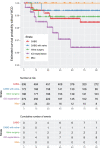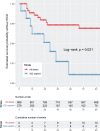Wearable cardioverter defibrillator multicentre experience in a large cardiac surgery cohort at transient risk of sudden cardiac death
- PMID: 35174386
- PMCID: PMC9070494
- DOI: 10.1093/ejcts/ezac086
Wearable cardioverter defibrillator multicentre experience in a large cardiac surgery cohort at transient risk of sudden cardiac death
Abstract
Objectives: The wearable cardioverter defibrillator (WCD) is an established, safe, effective solution, protecting patients at risk of sudden cardiac death. We specifically investigated WCD use in cardiac surgery patients since data for this patient group are rare.
Methods: Retrospective data analysis in 10 German cardiac surgery centres was performed. Cardiac surgery patients with left ventricular ejection fraction (LVEF) ≤35% or after implantable cardioverter defibrillator (ICD) explantation who received WCD between 2010 and 2020 were assessed using LifeVest Network data.
Results: A total of 1168 patients with a median age of 66 years [interquartile range (IQR) 57-73] were enrolled; 87% were male. Clinical indications included coronary artery bypass grafting (43%), valve surgery (16%), combined coronary artery bypass graft/valve surgery (15%), ICD explantation (24%) and miscellaneous (2%). The median wear time of WCD was 23.4 h/day (IQR 21.7-23.8). A total of 106 patients (9.1%) exhibited ventricular tachycardia. A total of 93.2% of episodes occurred within the first 3 months. Eighteen patients (1.5%) received 26 adequate shocks. The inadequate shock rate was low (8 patients, 0.7%). LVEF improved from a median of 28% (IQR 22-32%) before WCD prescription to 35% (IQR 28-42%) during follow-up. Excluding ICD explant patients, 37% of patients received an ICD.
Conclusions: The risk of sudden cardiac death is substantial within the first 3 months after cardiac surgery. Patients were protected effectively by WCD. Due to significant LVEF improvement, the majority did not require ICD implantation after WCD use. Compliance was high despite sternotomy. This multicentre experience confirms existing data regarding effectiveness, safety and compliance. Therefore, WCD should be considered in cardiac surgery patients with severely reduced LVEF.
Keywords: Cardiac surgery; Heart failure; Postoperative mortality; Sudden cardiac death; Ventricular arrhythmia; Wearable cardioverter defibrillator.
© The Author(s) 2022. Published by Oxford University Press on behalf of the European Association for Cardio-Thoracic Surgery.
Figures






References
-
- Gräsner J-T, Lefering R, Koster RW, Masterson S, Böttiger BW, Herlitz J. et al. EuReCa ONE-27 Nations, ONE Europe, ONE Registry: a prospective one month analysis of out-of-hospital cardiac arrest outcomes in 27 countries in Europe. Resuscitation 2016;105:188–95. - PubMed
-
- Moss AJ, Zareba W, Hall WJ, Klein H, Wilber DJ, Cannom DS. et al.; Multicenter Automatic Defibrillator Implantation Trial II Investigators. Prophylactic implantation of a defibrillator in patients with myocardial infarction and reduced ejection fraction. N Engl J Med 2002;346:877–83. - PubMed
-
- Moss AJ, Hall WJ, Cannom DS, Daubert JP, Higgins SL, Klein H. et al. Improved survival with an implanted defibrillator in patients with coronary disease at high risk for ventricular arrhythmia. Multicenter Automatic Defibrillator Implantation Trial Investigators. N Engl J Med 1996;335:1933–40. - PubMed
-
- Appoo J, Norris C, Merali S, Graham MM, Koshal A, Knudtson ML. et al. Long-term outcome of isolated coronary artery bypass surgery in patients with severe left ventricular dysfunction. Circulation 2004;110:II-13–II-17. - PubMed
Publication types
MeSH terms
LinkOut - more resources
Full Text Sources
Medical

